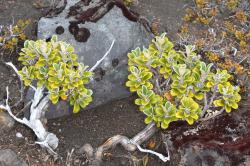- Taxon
- Gallery
- ≡ Senecio bidwillii Hook.f., Bot. Antarct. Voy. II. (Fl. Nov.-Zel.) Part I, 150 (1852)
- = Senecio viridis Kirk, Stud. Fl. New Zealand 350 (1899) nom. illeg., non Senecio viridis Phil. 1891
- ≡ Senecio bidwillii var. viridis Cheeseman, Man. New Zealand Fl. 383 (1906)
- ≡ Brachyglottis bidwillii var. viridis (Kirk) B.Nord., Opera Bot. 44: 29 (1978)
Compactly branched shrub up to 1 m. tall; branches stout; branchlets, petioles and infl.-branchlets clad in dense appressed soft white to buff tomentum. Lvs elliptic- to obovate-oblong, very coriac., 2–2.5 × 1–1·5 cm., on stout petioles falling to leave prominent lf-bases, glab. and shining above, clad in dense appressed soft tomentum below, midrib and veins not prominent below. Panicles subcorymbose, up to 5 cm. diam.; capitula discoid, campanulate, up to 1·5 cm. diam.; phyll. narrow-oblong, coriac., subacute, tomentose on back. ♀ 3–5; disk-florets ∞, deeply 5-lobed. Achenes linear-oblong, 3 mm. long, ribbed, glab.; pappus-hairs stiff, white, up to 5 mm. long, barbellate.
[From: Allan (1961) Flora of New Zealand. Volume 1 as Senecio bidwillii Hook.f.]




